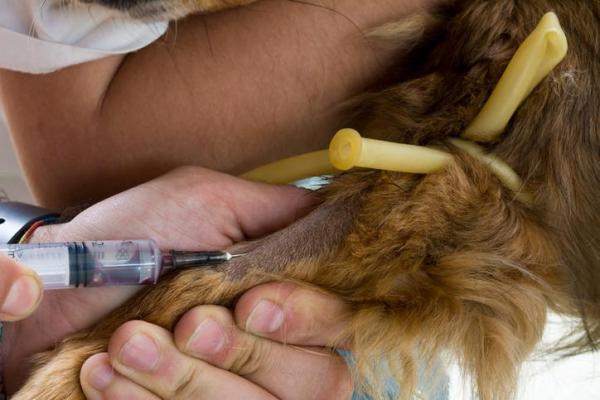Normal Glucose Levels in Dogs



See files for Dogs
As caregivers to our dogs, we need to ensure all of their needs are met. Unfortunately, some of our canine's health considerations aren't always apparent. This is why regular checkups at the vet will help us to ensure they are kept away from hidden dangers. Checking their blood glucose levels are a way to ensure a dog is not at risk of diseases such as diabetes. There are sometimes other symptoms which prompt a blood test while other screenings are routine. In this AnimalWised article we will take a look at what are the normal blood glucose levels in dogs and interpret what this means in terms of lifestyle and care. We will also show you how these levels are measured as well as explain some of the related conditions when the readings are too high or too low.
Normal glucose levels in dogs
Glucose is a simple sugar found in the blood of animals which is then referred to as blood sugar. Normal blood glucose levels of dogs should be between 88 and 120 mg/dL. While there may be certain mitigating circumstances, values of blood sugar above or below these values often indicate the presence of certain pathologies. When a dog shows signs of a disease or illness, it is common for a veterinarian to take a blood sample for lab analysis. This is similar to human blood tests. In dogs, blood samples are usually taken from the front legs, although samples taken from the hind legs or jugular (in the neck) are also performed.
The basic analysis usually takes two main forms consisting of:
- Hemogram: this deals with measuring different parameters such as the hematocrit, hemoglobin, platelet or leukocyte levels. This can help determine the presence of anemia in a dog as well as help us understand which type it may be (generative, non-regenerative, etc.). It can also show us if there is an infection present.
- Biochemistry: this is where the glucose measurement comes in as, combined with other parameters, it helps us to qualify the functionality of their vital organs. These may include creatinine and urea production in the kidneys or GOT and GPT tests for the liver.
After analysis, if the levels are revealed to not be within the normal ranges, the dog may or may not show symptoms. This is why the vet will have to perform a physical examination and may even have to send for more tests to reach an appropriate diagnosis.
Changes in normal canine glucose levels
Unhealthy blood glucose levels are those which are higher than 120 mg/dL or lower than 88 mg/dL. When the levels are too low, the dog is likely hypoglycemic and hyperglycemic when too high. These different clinical pictures will present in different situations such as increased thirst, urine or weakness.
Dogs consume glucose via their diet (i.e. their food intake). This means their blood sugar levels will go up after eating, before deceasing again the further away from the meal they get. Glucose fulfils important functions throughout the body, particularly in providing energy during metabolic processes. It is regulated by insulin, a hormone produced in the pancreas. Without insulin (or with too low levels of insulin), the dog will develop hyperglycemia which we may know as diabetes mellitus. Hypoglycemia can be caused by an insulinoma, a tumor in the pancreas which affects insulin production.

Hyperglycemia in dogs
As we have said, blood sugar levels above 120 mg/dL lead to hyperglycemia. The causes of this condition are various, but the most well known is perhaps diabetes since this is also a common disease in humans. Cushing's Syndrome (also known as hyperadrenocorticism) can cause hyperglycemia as can pancreatitis, consuming medications like glucocorticoids or even kidney failure.
In this section we will take a closer look at diabetes mellitus and its links to hyperglycemia. Diabetes can be either type 1 or type 2 and it can be found relatively frequently in dogs. It occurs more regularly in females over 6 years of age which is why it is important to to submit the dog to an annual check up with blood and urine tests after this time. With these tests we can detect early onset diabetes even before other symptoms occur.
The cause of diabetes is essentially an inadequate production of insulin. Insulin allows glucose to enter into cells in order metabolize and release energy. This lack of insulin means glucose sin't processed and there is too much of it in the blood and urine (the latter known as glucosuria). They will dehydrate more quickly and urinate more frequently, leading to them drinking more water than is normally appropriate. Dogs will eat more during the early stages, but steadily lose their appetite as the disease progresses. Despite eating more at the beginning, they may still lose weight. The first symptoms of diabetes in dogs are:
- Increased urine excretion (polyuria)
- Thirst (polydipsia)
- Increased appetite
- Weight loss
Early onset diabetes may need lab tests to determine. However, when the disease advances more noticeable symptoms will develop. These include:
- Lethargy
- Loss of appetite
- Vomiting
- Dehydration
- Cataracts
- Weakness
- Coma
Once a diagnosis is made the treatment will consist of insulin injections and a specific diet for diabetic dogs. The vet will be responsible for establishing this treatment and will need o continue periodic evaluations to ensure the course of treatment is effective. This is particularly the case in terms of how much insulin needs to be administered. To control the treatment's effectiveness, weight control is also important. A strict schedule of meals and insulin injections will need to be created and scrupulously followed.
Hypoglycemia in dogs
When the blood sugar levels of a dog are less than 88 mg/dL, this will indicate they have hypoglycemia. While dogs with diabetes need insulin injections for treatment, dogs who are hypoglycemic have too little glucose in their blood. If this happens the dog may have these symptoms:
- Become disorientated
- Oversleeping
- Stagger while walking
- Have convulsions
- Enter a coma
When a dog who is hypoglycemic overexerts themselves, they can collapse, go into a coma and even die as their body shuts down. This is particularly the case if we have a hunting or racing dog with undiagnosed hypoglycemia.
In puppies, especially with very small breeds, hypoglycemia may occur due to stress. There may also be an underlying condition such as an infection or a liver shunt (abnormal veins which prevent the passage of blood from the intestine to the liver). This latter case results in the build up of toxins as they are not removed by the liver. The symptoms these dogs present are similar to those described above.
Prolonged hypoglycemia can cause brain damage. Insulinoma is a rare disorder which manifests itself in a tumor in the pancreas. These tumors secrete insulin, resulting in the drop in glucose levels and is more prevalent in older dogs. The presentation of these symptoms should result in an immediate trip to the vet for an examination. An administration of glucose serum can restore normal blood glucose levels, but treatment requires a full understanding of the cause.
How to measure blood glucose levels in dogs
If we see that our dog displays symptoms which indicate they may have diabetes, we need to take them to the vet to confirm a diagnosis. The vet will do this by measuring the dog's blood glucose levels. In addition to reading their blood sugar levels, they will perform an examination and consider concurrent symptoms. Additionally, they will also measure for fructosamine levels as this will help the vet to understand their glucose levels up to 3 weeks before the blood is extracted. With a confirmed diagnosis, insulin therapy can begin.
To measure the glucose levels of a dog, it is normal for the vet to mark the readings against the glucose curve. This involves measuring over a 12 to 24 hour period. This information is used to set and adjust the insulin levels needed to treat a particular dog. The vet will also likely require the owner to take their own glucose level readings at home. To do this, they will need a home glucometer and adjust their insulin accordingly. To use a glucometer:
- Extract a drop of blood from the dog's ear (to reduce pain). Rubbing the ear beforehand stimulate the bloodflow.
- Puncture on the inside of the ear on a clean and hairless area. The vet should provide the correct type of needle or lancet to use for this procedure.
- place the drop of blood on a disposable test strip which accompany the glucometer and introduce the strip into the machine.
- With cotton or gauze, put pressure on the site of the blood extraction to stop further bleeding.
- The glucometer will display the glucose level reading which we will record to pass on to the vet for a comprehensive clinical picture.
The vet should be able to explain everything you need to know about using a glucometer and taking readings. It is important that we do not do this without their supervision or to self-medicate the animal. We may make mistakes and end up worsening the situation. This tool is used as a follow up after a vet's visit and acts as a control measure. If the vet does determine your dog has diabetes, it will be necessary to adapt their diet. We have an article on homemade recipes for obese dogs which may also help with diabetic dogs.

This article is purely informative. AnimalWised does not have the authority to prescribe any veterinary treatment or create a diagnosis. We invite you to take your pet to the veterinarian if they are suffering from any condition or pain.
If you want to read similar articles to Normal Glucose Levels in Dogs, we recommend you visit our Prevention category.








